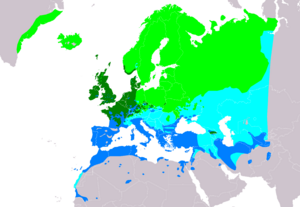Meadow pipit facts for kids
Quick facts for kids Meadow pipit |
|
|---|---|
 |
|
| Conservation status | |
| Scientific classification | |
 |
|
| Range of A. pratensis Breeding Resident Passage Non-breeding | |
| Synonyms | |
|
Alauda pratensis Linnaeus, 1758 |
The meadow pipit (Anthus pratensis) is a small songbird. It lives and breeds in many parts of Europe, Asia, and even Greenland. You can find them from Iceland all the way to Russia.
Most meadow pipits travel south for winter to warmer places like southern Europe, North Africa, and parts of Asia. However, some stay all year round in western Europe, often moving closer to the coast.
Contents
About the Meadow Pipit's Name
The meadow pipit was first officially described by a Swedish scientist named Carl Linnaeus in 1758. He gave it the scientific name Alauda pratensis. Later, it was moved to the group of birds called Anthus.
The name Anthus comes from an old Latin word for a small grassland bird. The word pratensis means "of a meadow," which makes sense because they live in meadows! The name "pipit" sounds like the bird's call, which is why it was chosen.
What Does a Meadow Pipit Look Like?
This little bird is about 14.5–15 cm (5+1⁄2–6 in) long and weighs 15–22 g (0.53–0.78 oz). It's mostly brown on top and a lighter, buff color underneath. It has darker streaks (lines) on its feathers. Its tail is brown with thin white edges on the sides.
The meadow pipit has a thin beak and pale, yellowish-pink legs. A special feature is its long back claw, which is longer than its other back toes. Its call sounds like a weak tsi-tsi. When it sings, it flies up in the air and makes a simple, repeating song.
Birds living in Ireland and western Scotland are a bit darker than those in other areas.
Similar Birds
The meadow pipit looks a lot like the red-throated pipit. The red-throated pipit has more streaks and, in summer, an orange-red throat. It also looks similar to the tree pipit, which is slightly bigger and has stronger markings on its face. You can tell them apart by their songs: the meadow pipit's song gets faster at the end, while the tree pipit's song slows down.
Where Meadow Pipits Live
Meadow pipits love open spaces. You'll often find them in pastures, bogs, and moorland, which are areas with low-growing plants. They can also be found in farm fields. In winter, they might move to salty marsh areas or even open woodlands.
These birds usually stay on the ground to find food. But they like to perch on shrubs, fences, or power lines to look out for danger.
There are about 12 million pairs of meadow pipits in the world. They are very common in the northern parts of their range, especially in the uplands of Britain. However, their numbers have been going down in some areas, like French farmlands.
Meadow Pipit Behaviour
Reproduction and Life Cycle
Meadow pipits build their nests on the ground, hidden in thick plants. A female usually lays between two and seven eggs, but most often three to five. The eggs hatch after 11 to 15 days. The baby birds, called chicks, are ready to leave the nest about 10 to 14 days after hatching. Many meadow pipit pairs raise two groups of chicks each year.
This bird is often a host for the common cuckoo. This means cuckoos lay their eggs in the meadow pipit's nest, and the pipit parents raise the cuckoo chick. Meadow pipits are also an important food source for birds of prey like merlins and hen harriers.
What Meadow Pipits Eat
Meadow pipits mainly eat insects and other small creatures without backbones, like spiders. They usually go for tiny items, less than 5 mm (3⁄16 in) long. In winter, they also eat seeds from grasses, sedges, rushes, and heather. They also enjoy crowberry berries during the colder months.
Gallery






